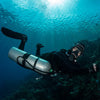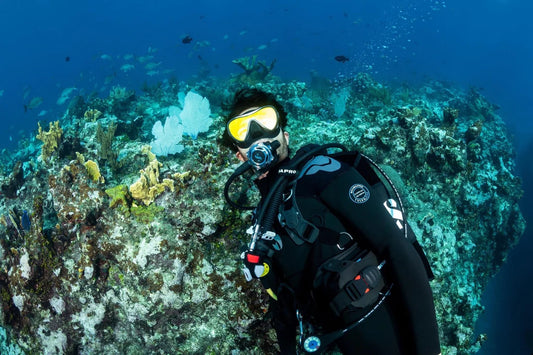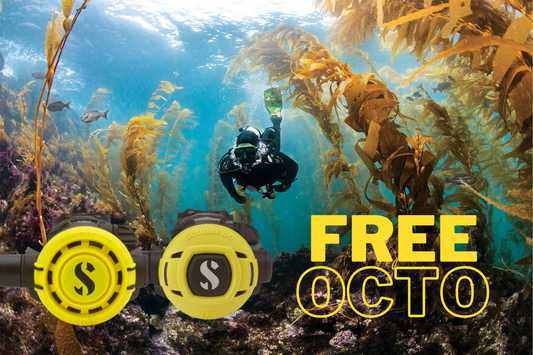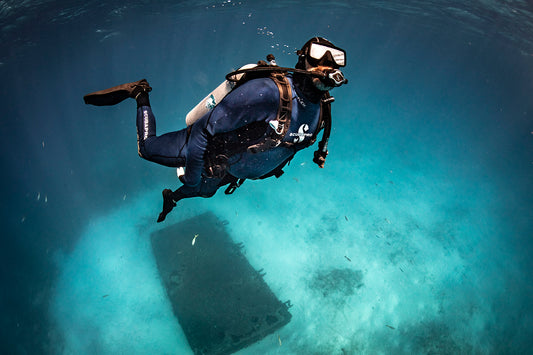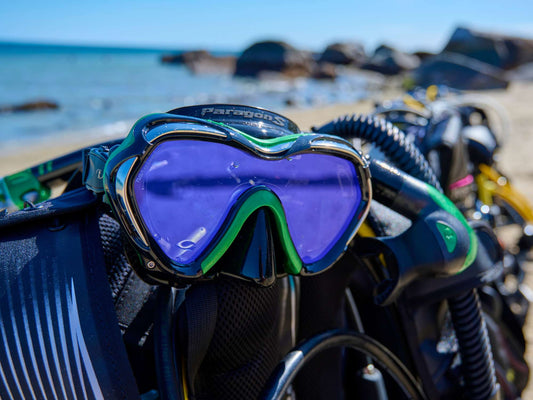Manta rays are part of the Mobulidae family, which also includes mobula or devil rays. There are 2 main species: Manta birostris that are oceanic and migratory and Manta alfredi that are smaller and commonly sighted closer to shore, often in groups. Manta birostris can be found in the Indian, Atlantic and Pacific oceans. They weigh up to 2 tonnes, grow to a whopping seven metres across, and have a calcified lump at the base of their tail. Their belly markings are mainly located under the gill slits. Manta alfredi is widespread across the Pacific, Indian and Atlantic oceans, growing up to 3.5 metres across with markings evident across their whole belly.
Mantas have the biggest brain of any fish. They are highly intelligent and are thought to have self-recognition. They often engage with divers and enjoy social aggregations with other mantas when feeding or in courtship. They are filter feeders and swim with their mouths open, using cephalic fins at the front of their head to direct plankton, crustaceans and smaller fish into their mouths. They have small teeth that are only used to chew their food.
Sadly, manta rays are classed as vulnerable in the IUCN Red List of Threatened Species due to overfishing, being caught as bycatch and because they are targeted for their gill rakers. In Chinese medicine gill rakers are thought to be a cure for cancer and other ailments and to boost the immune system (none of which has been scientifically proven). Female mantas are also late to reach sexual maturity - at around ten years old. They don’t reproduce every year, pregnancies are long and they often only carry one pup.
Like a human fingerprint, the unique nature of a manta ray’s ventral spots (belly markings) allows scientists to identify individuals. This information helps reveal migration patterns, reproduction habits and if there is a population in a specific area. Images of scarring can also help identify previously logged individuals. By submitting photos of manta rays that you may have taken underwater, you too can contribute to conservation efforts and manta research. Go to mantatrust.org or mantamatcher.org to log your images.
See our guide to some of the best places to have jaw-dropping encounters with the elegant manta rays of the world.
- Socorro Islands, Mexico
The Revillagigedo Archipelago was declared a UNESCO World Heritage Site in 2016 and a National Park one year later. A no take zone exists 12 miles around the islands as they contain one of the world’s largest aggregations of sharks and manta rays. Approximately 225 nautical miles off the Mexican coast of Cabo San Lucas is the first of the Socorro Islands called San Benedicto. On the western side is El Boiler. The dive site gets its name from the bubbling water that moves around an underwater seamount frequented by giant Pacific mantas. Be prepared to experience some of the world’s largest chevron (black and white) and melanistic (black) mantas here, engaging with your bubbles as they enjoy barrel rolling to feed and get cleaned in the current. 25% of the manta population in Socorro are black mantas.
- Southern Mozambique
Southern Mozambique is one of the few destinations where you can dive with both species of Manta, often at the same time. These warm Indian Ocean waters have one of the world’s largest catalogued populations of manta rays. This is because the 200km coastline has unique counter-cyclic eddies, producing a rich year-round source of zooplankton. Tofo is at the centre and its resident population can be encountered throughout the year at cleaning stations, where small fish relieve the mantas of parasites. Tofo is teeming with other marine life including whale sharks from October to March and humpback whales from June to September.
- Maldives
Hanifaru Bay, in the northern Baa Atoll is a UNESCO Biosphere Reserve where massive numbers of mantas and whale sharks aggregate annually. Every year between May and October reef mantas (up to 200 at any one time) gather to feed on large plankton blooms. The plankton gets “stuck” within the small horseshoe shaped lagoon and the mantas form feeding chains to gulp it up! Encounters are snorkelling only, but divers can often see the reef mantas around other cleaning stations in the area. Hanifaru is best experienced by liveaboard. Manta alfredi also follow plankton trails in the lagoons and around the Thilas of the more central Ari Atoll.
- Yap
Mantas are seen consistently throughout the year around the tiny island of Yap in remote Micronesia. It is the best place to dive with reef manta rays in the Pacific, which are protected by law. Best time is mating season between December to April when you can often see mating “trains” as courtship behaviour. The diving in Yap includes drifts in channels, drop-offs, gentle slopes and multiple cleaning stations. The Yap Manta Ray Identification database is a joint project with Manta Trust, Micronesia Conservation Coalition and Manta Ray Bay Resort & Yap Divers.
- Indonesia
Nusa Penida, Bali: Sightings at Nusa Penida are year round. An early morning dive at Manta Point will reward you with lots of small, inquisitive reef mantas at various depths, while the shallow Manta Bay attracts the hungry ones enjoying the Indonesian Throughflow. This large flow transfers the water from the Pacific to the Indian Ocean, which means the strait between Bali and Lombok always has fresh nutrient rich currents.
Komodo National Park: Both species of manta frequent Komodo all year round, cleaning, feeding and mating. While Manta Alley is the most iconic site, up to 80 individuals of reef manta can be seen at feeding sites like Karang Makassar in the north. Pregnant females are often sighted!
Raja Ampat: Both species of manta live around the sandy channels and reefs of Raja Ampat National Park. Best time to dive with them is between December and April. Oceanic mantas are regularly seen at ‘Blue Magic’ and’ Magic Mountain’ during these months.

